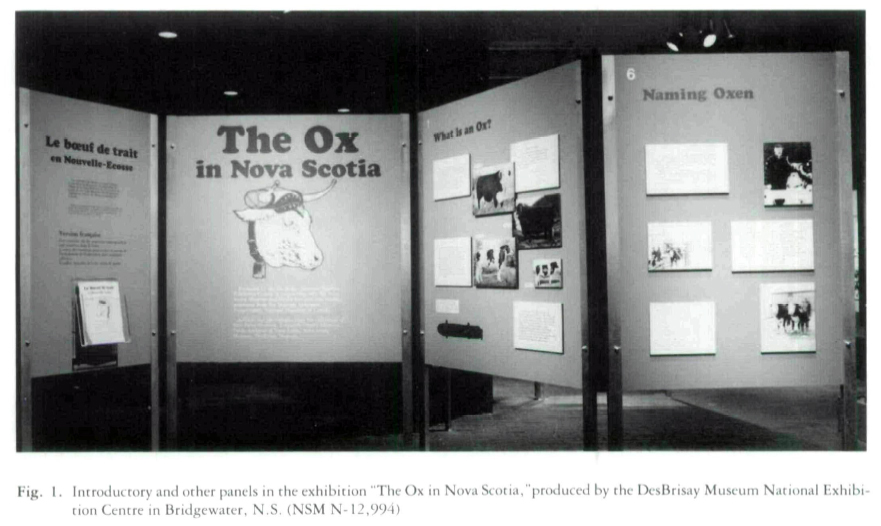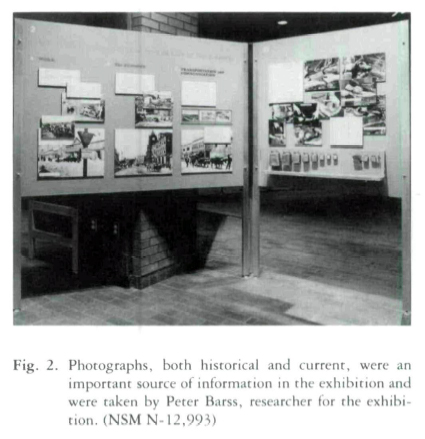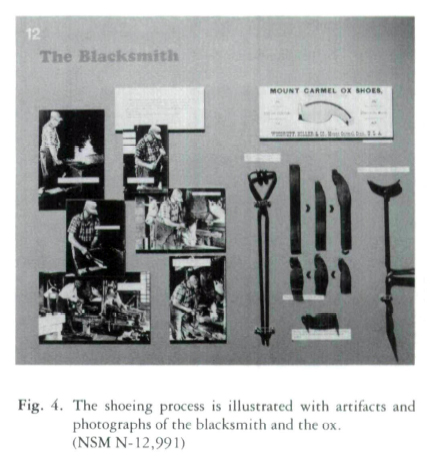Reviews / Comptes rendus
DesBrisay Museum National Exhibition Centre, "The Ox in Nova-Scotia"
 Display large image of Figure 1
Display large image of Figure 11 The intent of "The Ox in Nova Scotia" is to show the importance of the ox in the development of the economy, transportation and folklore of Nova Scotia. A travelling exhibition, it is scheduled for viewing at eight sites throughout Nova Scotia. Produced by the DesBrisay Museum National Exhibition Centre in Bridgewater, with design, construction and circulation by the Nova Scotia Museum, the exhibition received financial assistance from the Museums Assistance Programme of the National Museums of Canada. Contributions in the form of photographs and artifacts were made by various museums and archives and by present and former teamsters from around the province. Research and photography were carried out by Peter Barss, whose previous exhibitions "Images of Lunenburg" and "Older Ways: Traditional Nova Scotian Craftsmen" lend their down-to-earth style and fine portrait photography work to this exhibit.
2 The ox does not seem a likely subject for an exhibition, but after viewing the exhibit one can see that the ox should be entitled to its own chapter in Nova Scotian history. The exhibit is divided into sixteen sections, each dealing with one aspect of the subject. The first unit — "What is an ox?" — prominently displays a castration tool, convincing proof that an ox is not just "a different breed of cow." Coloured pictures of various breeds of domestic cattle serve to illustrate which breeds can be cross-bred to produce certain desired traits in an ox. The remainder of the exhibit takes the viewer through sections on the importance of oxen in Nova Scotian work, economy, transportation, and communication; buying and selling steers; breaking steers; the teamsters; yokes and fastenings; naming oxen; children and oxen; oxen at work on the farm, in logging, along the coast and in transportation; long hauls by oxen; ox bells; yoke making; the blacksmiths; ox lore; exhibitions and parades; and the ox whip. What more could be said about the ox? Logically it would seem that the sections on oxen gear should be grouped together, but by spacing these subject areas, the viewer is better able to focus on each item.
 Display large image of Figure 2
Display large image of Figure 23 Each segment uses photographs, artifacts and text, the latter sometimes in the form of a quotation from a teamster. The artifacts are limited mainly to the gear worn. A good selection of yokes makes up one section. Single and double types of both neck and head yokes, as well as the accompanying head pads, leather straps, chains and backing pins, can be seen. Another section, a step-by-step photographic sequence of yoke making, shows the associated tools and the completed yoke. In the blacksmithing section, shoes at every stage, from the plain iron bar to the completed shoe, are displayed.
 Display large image of Figure 3
Display large image of Figure 3 Display large image of Figure 4
Display large image of Figure 44 Of particular interest in the exhibit are the quotations from the teamsters, some of whom still maintain teams. Among these people plain speech prevails: "He went to work and put 'em on the pole and never put no draw bolt into 'em, into the pole to hold 'em. He done this to fool 'em," Authenticity is added by the superb photographs of the teamsters with cigarette in hand or hat worn tilted to the side.
5 Two videotapes come with the exhibit, each about fifteen minutes long. One shows oxen hauling timber from the woods, while the other allows the viewer to see a blacksmith shoeing an ox — both feature the oxen and staff at the Ross Farm Museum where the videotaping was done by Media Services, Nova Scotia Department of Education.
6 Almost all of the text can be found in the booklet accompanying the exhibit. A few of the quotations are missing and, in the French version, they are paraphrased. The booklet makes a nice take-away souvenir although a few more photographs would have made the guide more interesting.
7 One apparent afterthought to the exhibit is the addition of a French-language booklet. Although likely a funding requirement, it somewhat spoils the look of the original title panel. The necessity of a French version is questionable if the exhibit does not travel beyond Nova Scotia since while the exhibit was displayed in Yarmouth, a town sandwiched between two large French-speaking areas, no French version copies were taken — even by people known to speak French at home.
8 One complaint heard about this exhibit was that the title is somewhat misleading since the text and photographs cover only the South Shore of Nova Scotia — from Halifax to Yarmouth. The use of oxen in Cape Breton or other parts of the province was not mentioned. Perhaps research revealed little new in these areas and so artifacts and photographs were procured from the nearest sources.
9 Children, other than 4-H members, did not appear to spend a great deal of time looking at this exhibit, but then children, as many adults, can "do" a museum or an exhibit in an incredibly short time. Perhaps they would be more impressed with a stuffed ox!
10 The exhibit lends itself to the use of local artifacts — at the Yarmouth County Museum it was supplemented by photographs and gear from a local teamster as well as by a model timber-laden sledge, recently made, complete with ax, whip, tea billy and even a bale of hay. On Heritage Day a real team came to the museum — "Bright" and "Lion" were successful crowd pleasers. The openings of the exhibit at Bridgewater and Halifax featured other "Brights" and "Lions" (the almost universal names for oxen).1
11 Of particular importance in all exhibits is the ability to attract new museum visitors — those who make an effort to visit the museum perhaps for the first time to view a special exhibition. This one was no exception — many visitors who may have previously thought that museums were too "cultural" for them came to the Yarmouth County Museum to see "The Ox" and will hopefully return.
12 This exhibit has elicited many favourable remarks and a number of return visits — both of which support this reviewer's idea that the exhibit is a winner. All who worked on "The Ox in Nova Scotia" can be proud of their involvement. Gary Selig, Curator of the DesBrisay Museum, and producer of this exhibit is to be congratulated and thanked.
Curatorial Statement
13 The DesBrisay Museum National Exhibition Centre does not have a fully equipped workroom. The person on staff who does research, exhibit planning, collecting, minor conservation, exhibit design and production and label writing is also the director. This resource base made it imperative for DesBrisay to enter into a cooperative venture with the Nova Scotia Museum in the production of "The Ox in Nova Scotia."
14 A grant was secured from the Museum Assistance Programme, National Museums of Canada, to hire a project researcher. This was necessary so that the exhibit project could be undertaken over a period of two to three years as opposed to the ten years it would take if institutional staff had to accumulate research information on an ad-hoc basis.
15 The project was expected to depend mainly upon information gathered through oral history research. Local photographer and journalist, Peter Barss, was hired in recognition of his special affinity for people of rural Nova Scotia, the expected audience for the research effort. His photographic skills were an asset in collecting photographic images from private collections.
16 An Advisory Committee was established to facilitate advisory assistance from the Nova Scotia Museum; as well as the director of the provincial museum, board members of the DesBrisay interested in the planning and preparation of the exhibit, the first major travelling exhibit to be produced by the museum, served on the committee.
17 Management of the project was somewhat difficult. The new research being undertaken could lead into a much bigger project than desired. It was decided to focus research on the South Shore and go further afield as time and resources permitted. Museums across the province were contacted in an effort to obtain the broadest representation for a Nova Scotia focus in the exhibit's theme.
18 The collection of the DesBrisay Museum was very weak in respect to oxen-related technology. It was thought that this type of material would not likely have survived and so the exhibition was expected to be predominately graphic in content. As the research activity increased, a number of artifacts were uncovered. Two collections were donated by private individuals to the exhibit project. This provided a more than adequate artifact base for the exhibit and the museum.
19 The design and physical production of the exhibit was carried on at the Nova Scotia Museum, adding to the difficulties of coordinating the exhibit. Because close collaboration and communication was imperative, a liaison person with the Nova Scotia Museum was appointed to channel information materials and help arrange meetings with various staff involved in the project.
20 The Media Services Section of the Provincial Department of Education, located away from the Nova Scotia Museum, produced two videos on the exhibit's theme. This group became the fourth party outside of the DesBrisay Museum to be involved in the joint exhibit project.
21 The project researcher pursued topics developed through a proposed storyline for the exhibit. Monthly reports on progress ensured that research requirements were being met.
22 Meetings and conversations were held frequently with the Chief Curator of Exhibits and the designer at the Nova Scotia Museum. The influx of artifacts during the research effort changed the design approach part way into the project. In addition, as a result of the large amount of photographic and text content, it was decided that French translation would be provided in a publication form carried by the visitor. Translated text from the exhibit was organized to correspond with numbered panels in the exhibit.
23 The Ross Farm Museum, the living agricultural museum of the Nova Scotia Museum Complex, was the scene for the video productions. This museum is located in Lunenburg County about 60 km from DesBrisay. The museum makes use of oxen in its normal activities and was an ideal setting to document the oxen at work in logging operations and the blacksmith making and fitting shoes to a team of oxen.
24 The Ross Farm Museum was exceptionally cooperative in the video programming and other aspects of the project. And, in turn, participating in these productions created an awareness among the Ross Farm staff that certain routine activities which were not part of public programming to date could be of potential interest to the public.
25 The three-year project ended about two weeks past the scheduled opening date for the exhibit. This was only possible through the cooperation of the groups directly involved in the project and the number of museums contributing artifacts and photographs from their collections.
26 The DesBrisay Museum prides itself in being able to contribute to the province's travelling exhibitions programme. The resulting collection is a welcomed addition to the museum's holdings. During the oral history research, information arose which led to the acquisition of a home-made child's toy known as the "wooden ox." This artifact is of a type that would not under normal circumstances have survived the years. It was through oral history research that we were able to know of the existence of such an artifact.
27 Another positive result of the oral history research was the human perspective on a life associated with oxen which is evoked through the exhibit.